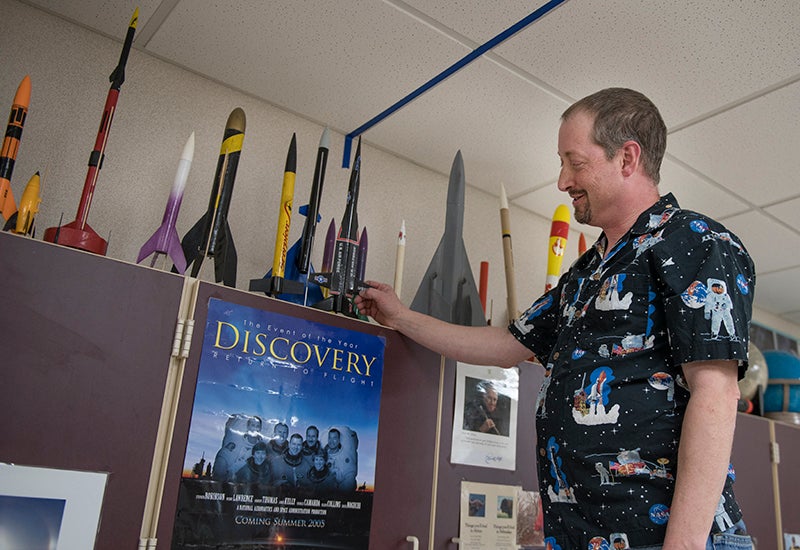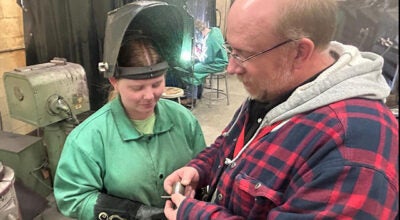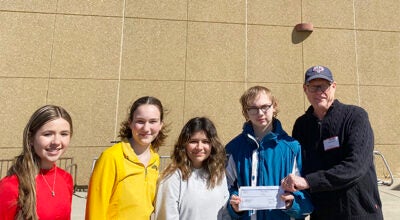Teacher loves science to the moon and back
Published 1:00 pm Saturday, February 23, 2019

- Albert Lea High School science teacher Ken Fiscus is all about outer space. So much so, that he was almost considered to be an astronaut. Colleen Harrison/Albert Lea Tribune
Ken Fiscus wants his students to know a lot of things. There’s the 2004 earthquake and subsequent tsunami in the Indian Ocean, the Iceman, what a solar eclipse looks like — that’s a big one. But what he hopes his students really learn is that they’re not the center of the universe.
In the solar system, that would be the sun.
Technically.
But that’s not the impression you get when you walk into Fiscus’s science classroom at Albert Lea High School. On the right wall immediately adjacent to the entrance — below the laminated paper “death quilt” carrying the 250,000 tally marks that represent those killed in the 2004 tsunami — is one of the three “Starry Night” recreations scattered about his room. This one is built from miniature NASA-themed photos.
If your eyes travel left, past the light switch and the international tsunami warning symbol, past the high cabinets adorned with 33 multicolored rockets of varying size and design, past another “Starry Night” reproduction, is the 2004 class of astronauts on a large poster. Among the names and faces, some stand out as familiar. Fifteen bear the special mark of Ken Fiscus: a yellow binder paper reinforcement sticker, like a thick solar eclipse, next to their picture. Those are the ones Fiscus has met.
In his classroom, the 2011 National Space Educator flicks through the set of plastic hangers carrying over 50 of his science shirts. On yearbook picture day, he doles them out to students.
Here’s the shirt from the Nebraska Star Party, held annually near Valentine, Nebraska. It’s signed by eclipse expert Fred Espenak, a black signature on an otherwise white shoulder. Here’s the shirt he picked up in the NASA gift shop when he was one of 35 finalists to become an educator astronaut. Here’s one that glows in the dark. Here’s the one, blue with orange swirls and planets, that he calls his Mr. Frizzle shirt.
From the outside, Fiscus’s universe seems firmly focused on a different heavenly body. For Fiscus, it’s the moon.
Launch
Fiscus started teaching science at Albert Lea HIgh School in 1991, the same year he saw his first solar eclipse.
A minister’s child who calls Wayne, Nebraska, home, Fiscus attended Nebraska Christian College in Norfolk, Nebraska. There, he met his wife, Kelli. She made the cut because she agreed to name their first son after a star Fiscus picked off a star chart in high school: Rigel, the brightest star in the Orion constellation. (His daughter is named Meridian, which Fiscus said means “high point.”)
“I went to college not having a clue what I wanted to do,” Fiscus said.
He went to Nebraska Christian College because that’s where his parents went, he said. The college announced a cooperative with Wayne State that allowed Fiscus to receive his Bachelor of Arts and Bachelor of Science at the same time. The program instigated his career in teaching — a career choice that, in hindsight, made a lot of sense, he said.
“Duh, I was meant to be a teacher,” Fiscus said. “But I didn’t know that.”
He received his Bachelor of Science in education earth science, history and geography and his Bachelor of Arts in Biblical studies.
“People go, ‘Really? Biblical studies and science?’” Fiscus said. “Well, you can function, you can believe in God and be a science teacher.”
Fiscus’s interview at Albert Lea High School was his first trip to Minnesota.
“I needed a job,” he said.
He was headed out of student teaching at a Cooperative Urban Teacher Education placement in Kansas City, Kansas, working with inner-city children and teaching English as a second language at night. A fellow CUTE teacher from Iowa shared a job list with him, and he saw Albert Lea’s district on there.
When he came to town for the interview, he had to stop on Fountain Street for ducks to cross.
“‘This could be a cool place,’” Fiscus said he remembers thinking.
Now, he’s in the midst of his 28th year, teaching students in Albert Lea how different earthquake waves work by running across the classroom and wiggling his arms. That’s why ninth-grader Emma Berg remembers how they work: She has a tiny Fiscus running to the other side of the space in her head.
“I think I’ve retained a lot more than I usually would because of how he taught,” fellow freshman Brennan McCalla said.
And it’s not just how, but what: McCalla remembers time spent studying the Iceman, a man mummified by ice in the alps on the border between Austria and Italy.
“I can tie anything into anything,” Fiscus said. That’s because math and science are merely tools to help you figure out the hows and the whys of the universe, he said.
Wendy Keszler, who has taught science alongside Fiscus at Albert Lea High School for 20 years, said she sees that mindset in how he teaches.
“He has all kinds of other strengths and talents that are not required of a teaching certificate,” she said. “… So, when he teaches — he teaches his topics and uses student interest to teach those topics, and that is very rare to find that in a teacher.”
For Berg, Fiscus’ passion for astronomy influenced her own. Keszler said she’s in the same boat.
“I took an astronomy course just because he was so passionate about it,” she said.
She found a physics professor who taught a night course. Now, she uses a section on astronomy in her course on physics to teach students about parallax motion.
Berg and McCalla see Fiscus trying to teach them about more than what fits in their textbooks.
“I try to show them that science matters,” Fiscus said. “It isn’t about worksheets.”
Almost an astronaut
Nonetheless, Fiscus had a hefty worksheet of his own to fill out when, under President George W. Bush, NASA announced its educator astronaut program in 2003.
“NASA realized they have an image problem,” Fiscus said. The average American had no idea what NASA did. And who better to educate the average American than science teachers?
When the press release came out, Fiscus said he had three emails that day.
“You’re applying,” the emails said.
He talked it over with his wife, then printed out 61 pages of instructions on how to fill out the application.
“We agreed that I should apply, and I’d never get picked,” he said.
After putting off the paperwork, he and his wife got a babysitter from their church one Saturday to knock it all out.
That was Feb. 1, 2003.
“The phone rings,” Fiscus said. “It’s the babysitter. She says, ‘Turn on your TV. The space shuttle Columbia just blew up over Texas.’ And I said, ‘Well, there goes that. Aren’t you glad we didn’t do the paperwork?’”
He was certain the program wouldn’t continue.
It did. And so did he — through more cuts than he expected. He had to submit curriculum he’d developed as a teacher (“Apparently they liked that,” he said). Before his interview, he hit the treadmill with an exercise regimen suggested by another teacher. He said he went from no exercise to running five miles non-stop in five weeks.
He went through all the tests: vision exams, psychiatric screenings, cancer screenings, X-ray tests. He passed them all. If he had kept going, students would have seen Fiscus’ own torso, covered in the orange NASA jumpsuit, on the 2004 NASA class of astronauts on the poster in his classroom.
If he had kept going, Fiscus said the consistent medical screenings required of astronauts may also have caught his autoimmune disease earlier.
“This is a much more recent plot twist,” he said.
In 2016, Fiscus was diagnosed with Churg-Strauss Syndrome, a disease in which blood vessel inflammation can restrict blood flow to vital organs and tissues, according to Mayo Clinic.
“You know it’s a winner when it’s named after two pathologists,” he said.
Fiscus felt it in his legs.
He was tired. At school, he didn’t leave his room to conserve energy. His daughter brought him food in the classroom.
“She was my lifeline,” he said.
During MEA break, he woke up at 2 a.m. to take more aspirin for his legs. He was partially blind in his right eye, he said.
“That got my attention,” Fiscus said.
He asked the doctors what they could do for his eye — he’s a visual person.
“‘You’ve got bigger problems than your eye,’” he said they told him.
He went through five rounds of chemotherapy and now takes medication to help manage the diagnosis.
Fiscus said he wasn’t chosen to be an educator astronaut in 2003 because, in the interview, he asked not to be.
They weren’t going to the moon.
“I had little kids at home,” he said.
He knew, off the top of his head, the number of astronauts who died in shuttle missions by 2003. It was 14.
“I didn’t want to risk my life not going to the moon,” Fiscus said.
Afterward, he said it was a constant yo-yo in his mind: Was this the right decision?
He said he knows now it was. He was in it for the moon, not the International Space Station.
“I’d even consider a one-way mission,” Fiscus said.
Eye on the sky
It’s not totally fair to say Fiscus is purely lunar driven.
Every time there is a total solar eclipse, Fiscus also has a vested interest in the sun.
He can’t quite pinpoint when he first started loving science itself. When he was a child, he was allowed to get dirty. He was into bugs and fossils and turtles: “Everything,” he said.
Astronomy came later. At the same age as the students he now teaches in his earth science classes — eighth grade — his friend’s older brother moved to college and left behind two telescopes, Fiscus said. Together, they learned the sky.
Now, Fiscus builds his own in his spare time. He lends them to the student-started astronomy club, now in its second year at Albert Lea High School. Fiscus plans to use them for what he calls “ambush astronomy.”
“When people come out of basketball games, you know, there will just be nerds with telescopes,” he said. “No announcements — just, ‘Hey, want to look at the moon?’”
Fiscus has seen three total solar eclipses: the 1991 eclipse from Mexico, the 1998 eclipse from Aruba and the 2017 eclipse from Pawnee City, Nebraska.
“It’s the most beautiful sight in nature,” he said. “Period. Exclamation point.”
He doesn’t take that lightly. And when it came to planning for the 2017 eclipse — unlike with the paperwork to become an educator astronaut — he didn’t procrastinate.
Fiscus said he worked with Pawnee City, Nebraska, for five years ahead of the eclipse to prepare the community for the influx of tourists he believed them capable of drawing due to their position in the path of totality.
“He was really excited about this, and I guess if he hadn’t pushed it or talked to us about it, I’m not sure that we would have done anything or it would have been too late to do it,” said Yvonne Dalluge, vice president of Pawnee County Promotional Network.
Three years before the eclipse, on MEA break, Fiscus traveled to Pawnee City to brainstorm, he said. He looked at places where eclipse viewers could go for best viewing. Before Fiscus, Dalluge said she wasn’t sure whether anyone in Pawnee County had paid much attention to what being in the path of the total solar eclipse could mean. When he came down, she said Fiscus put on a program about what to expect and ideas for the area to do to prepare.
“He would email and say, ‘Did you do this? Did you do that?’” Dalluge said. “You know, and he had given us suggestions about food, what food we might have, and what we might call it to have it go with the eclipse names.”
According to Dalluge, they sold over 900 tickets for parking places between the five locations selected for viewing.
Several of those tickets went to a Fiscus-led caravan, which included several vans of people as well as a coach bus Fiscus rented himself and sold tickets for to break even.
Just like the last two eclipses, this one was a nail-biter, Fiscus said. The video he keeps on his phone, shot from a weather satellite, tells the story of the eclipse in grainy, stilted frames: clouds, clouds, clouds as the moon travels northwest to southeast, until, for just over two minutes at just after 1 p.m., the clouds parted and eclipse viewers removed their glasses in the midday dusk to see the shimmery edges of sun peeking out around the black silhouette of moon.
While planning the trip and the event was a lot of work, Fiscus’ eyes tell you it was a no-brainer.
“People have to see this,” he said. “… It’s immoral to keep something that cool to yourself.”
He unlocks his cell phone, nestled into its protective hunter orange case, to check on something. There on the screen, behind the rows of small, square app icons, the curved profile of the gray, pockmarked moon looms into partial view. Fiscus is ready for April 8, 2024.
And in the meantime, he is keeping one eye on the moon.
By the Numbers
28 – Years Fiscus has taught at Albert Lea High School
61 – Instruction pages Ken Fiscus said guided him through his NASA application to become an educator astronaut in 2003
2024 – Year of the next solar eclipse





